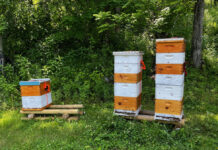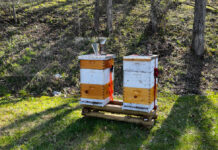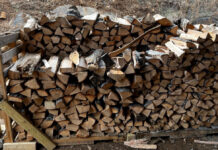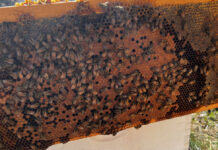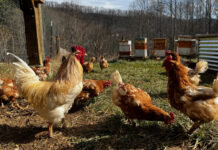
Besides researching and shopping for UTVs and spending far too much time weed whacking, it’s been a busy two weeks in the bee yard.
Back when I had only four hives, I signed up to buy a nucleus hive (or nuc) from Kamon Reynolds, a YouTube beekeeper based not so far away. Then I split my hives and my friend gave me two hives, jumping me up to seven hives. Suddenly, my need for new bees had lessened.
I got the nuc from Kamon despite not needing any more bees. This was in part because I had made a commitment and am a man of my word, but also to introduce some new genetics into my bee yard. If all goes well, his nuc will blossom into a large hive and I will get some honey from it this summer. Equally important, I hope to pull some frames of eggs and young brood from his hive and make a few queens, giving me new genetics. I can use these queens to replace my older queens, especially one that is too aggressive.
I have a mean hive in my home apiary and have learned to open it last so I can leave when I close it back up. All the stings I have had this year came from that hive. The bees in it will follow me across the bee yard and are very protective. Perhaps too protective. They are the only bees that will sting my gloves, trying unsuccessfully to get through the leather to my hands. As soon as I get an extra queen or two, I am going to pinch the source of mean bees off and replace her and her genetics before they give me more mean queens.
More Splits
If you are counting, you will notice four overwintered hives, plus two new ones, plus one split and one nuc equals eight hives, not ten. So how did I get ten?
Last week, I opened the new split and found that instead of three or four queen cells inside, I had seven. The first queen to be born will destroy the other queen cells, and if multiple queen are born at the same time, they will fight until only one queen is alive. Rather than waste queen cells, I decided to build a nuc of my own. I put the frame with three queen cells in the nuc, added a frame of brood from another hive, included a frame of resources, gave them a frame of drawn comb, and finished the five-frame nuc off with a brand new frame. The queen should be born by the time you read this, possibly out on her mating flight.
Then I checked my new hives, which are located five miles away in my out-yard, which is a term to mean a bee yard or apiary that’s not at the beekeeper’s home. The out-yard is at a lower elevation, so plant growth and spring blossom are a couple weeks ahead of my home apiary. The hives were exploding with bees and honey. The super I had put on one of the two hives was half full, with plump frames and bright new wax. Then I found a few queen cups, and most of them were charged. That’s a danger sign that the hive might swarm. So I split it, too, moving the queen into a new, single-deep hive and letting the queen cups remain unmolested so the old hive can hatch a queen.
More Bees Requires More Equipment
I now have nine hives plus the nuc, which is more beehives more than last year. The splits and the nuc are only one box or hive body, although that will change as they grow. Everything else is double-decker, and four of the hives have a total of seven honey supers on them. If they get anywhere close to full, that will be a good spring harvest.
Despite the winter setback, the hives are off to an excellent start. Now I just have to wait and see how things go. Much of it will be weather dependent. For example, I have to hope heavy rain doesn’t wash the nectar out of the tulip poplar blossoms.
I have enough equipment for ten double-decker hives, and I am bumping up against that right now. This weekend, I knocked together two more hive bodies using up the last of my unassembled equipment. I need to build at least six more medium boxes for supers and paint them. After that, I’ll make frames for all the new hive bodies and supers. Before harvest, I need to make a run to the bee store to buy more large hive bodies and lots of honey jars.
Ford Repair
In other good news, the ford that washed out a few weeks ago has been repaired. We were once again able to drive to and from the house. We return the borrowed Polaris Ranger we used to get up and down the mountain.
The Department of Transportation refused to repair the ford a second time, saying their contractor had erred when they repaired it after the hurricane. So we had our contractor do it. I would go so far as to say he didn’t just repair it, he upgraded it. This new ford is far less likely to get washed away in the future.
I realize this may remove one of the reasons we’re considering getting a side-by-side, but I’m likely proceeding with the purchase in any case.

